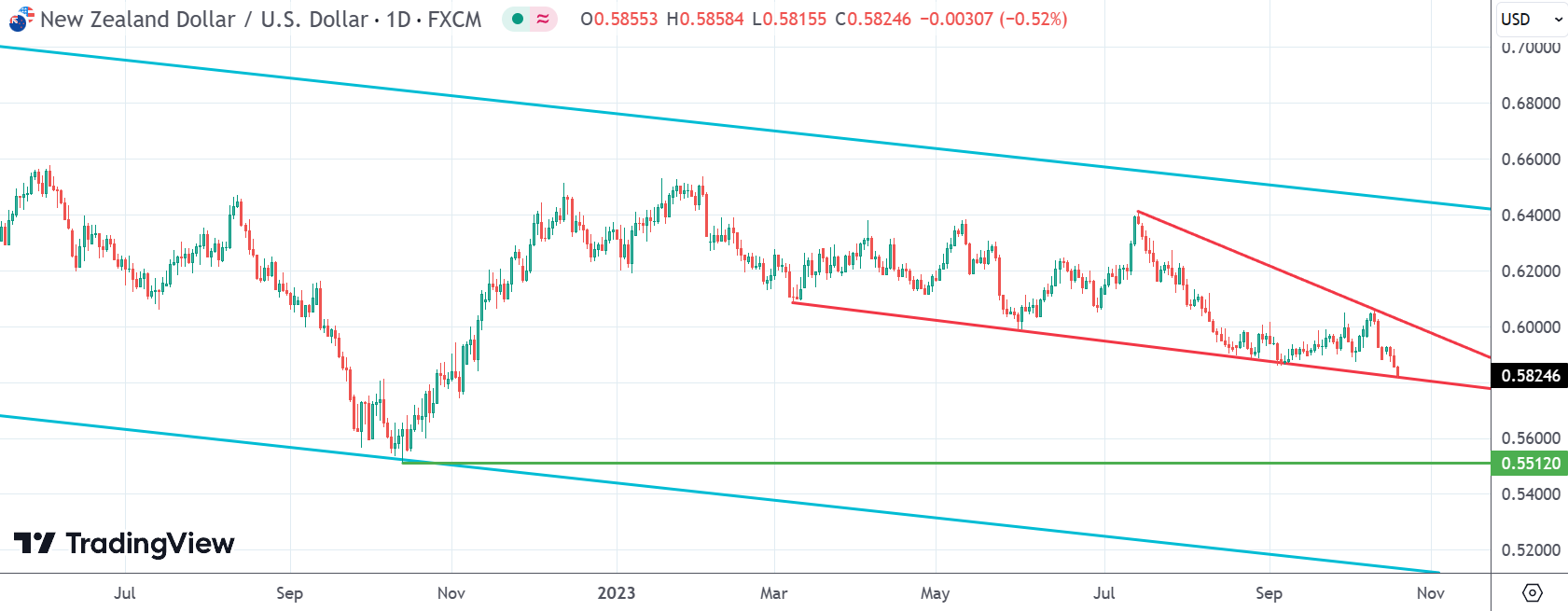The New Zealand dollar (NZD) fell for the third successive day against the US Dollar (USD) on Thursday, reversing all the gains of the previous month, and holding near crucial support after the third quarter CPI data rose more than expected even as inflation slipped year-on-year.
At the time of writing, the New Zealand US Dollar exchange rate (NZD/USD) was trading at 0.5822, down 0.55% on the day.
CIBC “expects NZD/USD to weaken to 0.57 through Q4 of this year.”
In its October edition of the monthly FX outlook, CIBC stated the “USD enjoyed a strong September, NZD/USD managed to eke out a small gain on the month. The outperformance of NZD against the crosses was due to a combination of a rapidly rebounding terms of trade, stronger than expected Q2 GDP, and a still decent environment for FX carry.”
According to the Chicago-headquartered commercial bank, the NZD/USD forecast is based on the continued US Dollar strength, weakening global growth, and a mispriced RBNZ.
The International Monetary Fund’s (IMF) global economic outlook, published in October 2023, projected global growth to slow to 3.0% in 2023 from 3.5% last year and 2.9% in 2024, way below the 2000-2019 average of 3.8%.
The IMF forecasts growth in advanced economies to slow from 2.6% in 2022 to 1.5% in 2023 while emerging and developing economies are expected to expand at 4.0% from 4.1% last year, a modest year-on-year decline.
CIBC estimates “a slowdown in global growth to weigh on the NZD through year-end, given New Zealand’s reliance on high-value agricultural exports. The RBNZ appears to be cognizant of these risks, as they recently stressed the negative effect that a global growth slowdown will have on the domestic economy.”
Earlier this month, the Reserve Bank of New Zealand left the benchmark Official Cash rate (OCR) unchanged at 5.5%, extending the pause for the third consecutive meeting.
The OCR is currently at its highest since November 2008, and as the central bank continues to fight inflation, it forecasts interest rates to remain elevated for some time, even as it anticipates inflation to drop to its target range by the second half of 2024.
Consumer inflation in New Zealand jumped to 1.8% in the third quarter of 2023 from 1.1% in the three months to June, Statista New Zealand reported on October 16th.
Meanwhile, inflation rose at an annual pace of 5.6% in Q3, cooling somewhat from the 6.0% reported in the previous month.
However, CIBC disagrees with policymakers that the impact of the full hike will be priced in by April 2024.
Instead, it thinks central bank officials will begin cutting interest rates in Q2 2024 to ensure real rates are not too restrictive.
“These headwinds support our call for NZD/USD to trade towards 0.57 by year-end,” CIBC believes.
NZD/USD Chart - Technical Analysis, Forecast
 Above: NZD/USD daily chart
Above: NZD/USD daily chart
NZD/USD is a long-term bearish trend, and while the pair registered a solid pullback from two-year lows last October, it hasn’t been able to break above the long-term bearish resistance.
The pair currently holds near crucial support at 0.5820, a close below which the losses could extend to the November 2022 lows of 0.5512.
On the upside, the immediate resistance is at 0.6005, followed by the long-term resistance at 0.6440.
Go long on the NZD at 0.5820 with a stop and reverse at 0.5770 for a profit target of 0.5990. If the stops are triggered, continue holding short trades with a fresh stop loss at 0.5840 for a profit target of 0.5550.